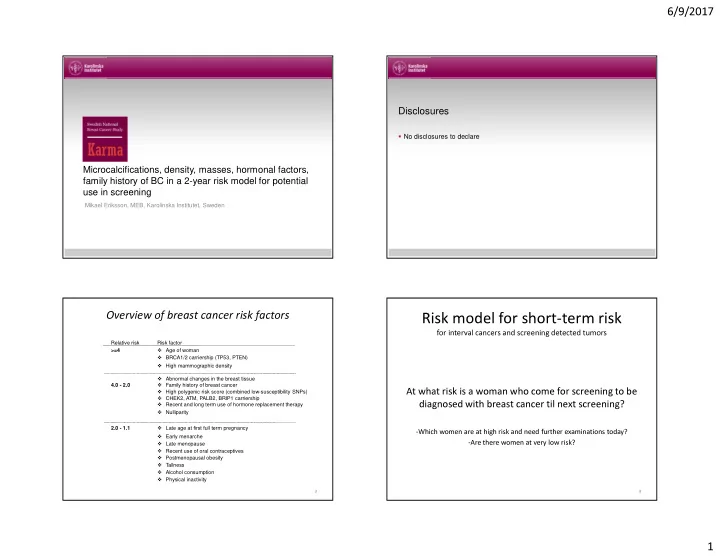

6/9/2017 Disclosures � No disclosures to declare Microcalcifications, density, masses, hormonal factors, family history of BC in a 2-year risk model for potential use in screening Mikael Eriksson, MEB, Karolinska Institutet, Sweden Overview of breast cancer risk factors Risk model for short-term risk for interval cancers and screening detected tumors Relative risk Risk factor >=4 � Age of woman � BRCA1/2 carriership (TP53, PTEN) � High mammographic density � Abnormal changes in the breast tissue 4.0 - 2.0 � Family history of breast cancer � High polygenic risk score (combined low-susceptibility SNPs) At what risk is a woman who come for screening to be � CHEK2, ATM, PALB2, BRIP1 carriership � Recent and long term use of hormone replacement therapy diagnosed with breast cancer til next screening? � Nulliparity 2.0 - 1.1 � Late age at first full term pregnancy -Which women are at high risk and need further examinations today? � Early menarche � Late menopause -Are there women at very low risk? � Recent use of oral contraceptives � Postmenopausal obesity � Tallness � Alcohol consumption � Physical inactivity 3 4 1
6/9/2017 Study design Characteristics of the women in the study 1 Study participant characteristics Incident cases Controls p-value Number of women 433 1732 . � KARMA incident breast cancer cases and controls (Swedish screening cohort) Age at breast cancer diagnosis, mean (SD 1 ) 59.0 (9.4) . . Years from mammography to breast cancer, median 1.74 . . � Mammographic density (measured using STRATUS software) Invasive breast cancer, % 88 . . Screening detected breast cancer, % 63 . . � Microcalcifications and masses (measured using iCAD, automatted reading) Age at mammography, mean (SD 1 ) 57.4 (9.2) 57.4 (9.2) 0.99 BMI, mean (SD 1 ) 25.6 (4.6) 25.3 (4.0) 0.19 � Age, BMI, family history of BC, menopause status, use of HRT 1 Age at menarche, mean (SD 1 ) 13.1 (1.4) 13.2 (1.5) 0.61 Parity, % 89 88 0.56 � Prospective nested case – control study design. 2-year follow-up. Age at first birth, mean (SD 1 ) 27.1 (5.4) 26.6 (5.2) 0.11 Current use of HRT, % 6.9 4.4 0.05 Postmenopausal, % 65 65 0.78 Breast cancer in family, % 19 13 4.5x10 -4 1 SD = standard deviation. 5 6 2 p-values for means were calculated with Student's T-test, medians with Wilcoxon rank-sum test and percentages with chi-square test. 1. Hormone replacement therapy Relative risks are higher in women with higher levels of Relative risks of breast cancer within 3 years of a mammographic density, number microcalcifications and negative mammography screen number masses Study participant and mammographic features HR (95% CI) Current use of HRT (same year user vs. previous or non-user) 1.3 (0.9-2.0) Family history of breast cancer 1.3 (1.0-1.7) HR 1 (95% CI) Mammographic features combined Percent mammographic density (cBIRADS 4 vs. 1) 4.8 (2.6-8.8) 1. (cBIRADS 1, microcalcification category 0, 0 masses), reference 1.0 Percent mammographic density (per standard-deviation) 1.6 (1.4-1.8) 2. (cBIRADS 2, microcalcification category 1, 1 masses) 4.3 (2.4-7.5) Number of microcalcifications (category 4 vs. 0) 2.0 (1.3-3.2) 3. (cBIRADS 3, microcalcification category 2, 2 masses) 7.9 (4.2-15.2) Number of masses (4 vs. 0) 1.7 (0.8-3.5) 4. (cBIRADS 4, microcalcification category >= 3, >=3 masses) 8.7 (4.7-16.0) Individual absolute difference between breasts Percent mammographic density 1.9 (1.2-3.0) Number of microcalcifications 2.8 (1.8-4.5) Number of masses 1.1 (0.6-1.9) 1 HR = hazard ratio. 2
6/9/2017 Discrimination performance in comparison Distribution of 2-year absolute risks in the KARMA cohort to established risk models Model AUC 95% CI 1. Percent mammographic density, age at mammography, BMI 0.63 0.60-0.65 2. Model 1 + family history of breast cancer, HRT use 0.64 0.62-0.67 3. Model 2 + absolute differences for calcifications, masses, density 0.70 0.68-0.72 4. Model 3 + interaction between percent density and masses 0.71 0.69-0.73 Established risk models for comparison Tyrer-Cuzick 0.63 0.60-0.65 Gail 0.56 0.53-0.58 Absolute 2-year risk 1 Percent Mean absolute Stratified 2-year risk 2 (risk group) women at risk 2-year risk 0-0.15 (low) 10.3 0.12 1.0 (reference) 0.15-<0.6 (general) 64.8 0.33 2.75 0.6-<1.6 (moderate) 22.9 0.82 6.83 N=60,807 women ≥1.6 (high) 2.0 1.95 16.2 Number of breast cancer cases diagnosed during study follow- Conclusion up stratified by baseline predicted risks in the KARMA cohort Quintile of predicted 2-year absolute risk at baseline Actually diagnosed cases Q1 Q2 Q3 Q4 Q5 Q5 / Q1 Q5 % � Three mammographic features together with Breast cancer cases (N=570) a few lifestyle factors identifies women in Current model 31 62 68 125 284 9.2 50 Tyrer-Cuzick 45 84 113 127 201 4.5 35 need of additional examination procedures Gail 103 88 102 107 170 1.7 30 Invasive cases (N=471) � There is a substantial group of low risk women Current model 27 58 61 108 217 8.0 46 Tyrer-Cuzick 40 67 97 107 160 4.0 34 that may have little benefit from Gail 90 71 83 89 138 1.5 29 mammography screening Interval cases (N=175) Current model 7 13 15 61 98 14 55 Tyrer-Cuzick 12 19 35 43 66 5.5 37 Gail 38 19 37 30 51 1.3 29 3
6/9/2017 Thank you! Per Hall, Karolinska Institutet Kamila Czene, Karolinska Institutet Yudi Pawitan, Karolinska Institutet Hatef Darabi 4
Recommend
More recommend